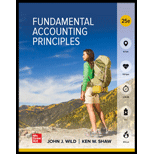
Concept Introduction:
Notes Payable:
Notes Payable are long term negotiable instruments of debt issued by corporate entities to secure funds from the public These funds are used to either fund long term capital expenditure or similar long term investment opportunities.
Notes Payable represent steady income for the investor in the form of periodic interest payments by the entity issuing the bond.
Notes Payable are issued at par (at face value), at premium (at higher than face value) or at a discount (at lower than face value).
Requirement 1:
Maturity Date of 90 Day Notes Payable undertaken on May 15.
Concept Introduction:
Notes Payable:
Notes Payable are long term negotiable instruments of debt issued by corporate entities to secure funds from the public These funds are used to either fund long term capital expenditure or similar long term investment opportunities.
Notes Payable represent steady income for the investor in the form of periodic interest payments by the entity issuing the bond.
Notes Payable are issued at par (at face value), at premium (at higher than face value) or at a discount (at lower than face value).
Journal Entries:
Journal entries are the first step in recording financial transactions and preparation of financial statements.
These represent the impact of the financial transaction and demonstrate the effect on the accounts impacted in the form of debits and credits.
Assets and expenses have debit balances and Liabilities and Incomes have credit balances and according to the business transaction, the accounts are appropriately debited will be credited by credited to reflect the effect of business transactions and events.
Requirement 2:
Want to see the full answer?
Check out a sample textbook solution
Chapter 11 Solutions
Fundamental Accounting Principles
- Please solve this General accounting questions step by steparrow_forwardCan you solve this accounting question with the appropriate financial analysis techniques?arrow_forwardThe Converting Department of Felton Industries had 1,500 units in work in process at the beginning of the period, which were 25% complete. During the period, 18,000 units were completed and transferred to the Packaging Department. There were 1,200 units in process at the end of the period, which were 60% complete. Direct materials are placed into the process at the beginning of production. Determine the number of equivalent units of production with respect to direct materials and conversion costs.arrow_forward

 AccountingAccountingISBN:9781337272094Author:WARREN, Carl S., Reeve, James M., Duchac, Jonathan E.Publisher:Cengage Learning,
AccountingAccountingISBN:9781337272094Author:WARREN, Carl S., Reeve, James M., Duchac, Jonathan E.Publisher:Cengage Learning, Accounting Information SystemsAccountingISBN:9781337619202Author:Hall, James A.Publisher:Cengage Learning,
Accounting Information SystemsAccountingISBN:9781337619202Author:Hall, James A.Publisher:Cengage Learning, Horngren's Cost Accounting: A Managerial Emphasis...AccountingISBN:9780134475585Author:Srikant M. Datar, Madhav V. RajanPublisher:PEARSON
Horngren's Cost Accounting: A Managerial Emphasis...AccountingISBN:9780134475585Author:Srikant M. Datar, Madhav V. RajanPublisher:PEARSON Intermediate AccountingAccountingISBN:9781259722660Author:J. David Spiceland, Mark W. Nelson, Wayne M ThomasPublisher:McGraw-Hill Education
Intermediate AccountingAccountingISBN:9781259722660Author:J. David Spiceland, Mark W. Nelson, Wayne M ThomasPublisher:McGraw-Hill Education Financial and Managerial AccountingAccountingISBN:9781259726705Author:John J Wild, Ken W. Shaw, Barbara Chiappetta Fundamental Accounting PrinciplesPublisher:McGraw-Hill Education
Financial and Managerial AccountingAccountingISBN:9781259726705Author:John J Wild, Ken W. Shaw, Barbara Chiappetta Fundamental Accounting PrinciplesPublisher:McGraw-Hill Education





